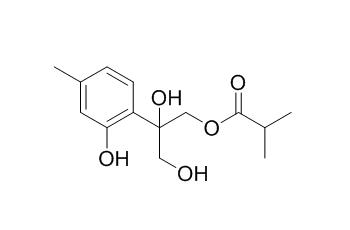8,9-Dihydroxy-10-isobutyryloxythymol
8,9-Dihydroxy-10-isobutyryloxythymol shows in vitro antibacterial and antifungal effects.
Inquire / Order:
manager@chemfaces.com
Technical Inquiries:
service@chemfaces.com
Tel:
+86-27-84237783
Fax:
+86-27-84254680
Address:
1 Building, No. 83, CheCheng Rd., Wuhan Economic and Technological Development Zone, Wuhan, Hubei 430056, PRC
Providing storage is as stated on the product vial and the vial is kept tightly sealed, the product can be stored for up to
24 months(2-8C).
Wherever possible, you should prepare and use solutions on the same day. However, if you need to make up stock solutions in advance, we recommend that you store the solution as aliquots in tightly sealed vials at -20C. Generally, these will be useable for up to two weeks. Before use, and prior to opening the vial we recommend that you allow your product to equilibrate to room temperature for at least 1 hour.
Need more advice on solubility, usage and handling? Please email to: service@chemfaces.com
The packaging of the product may have turned upside down during transportation, resulting in the natural compounds adhering to the neck or cap of the vial. take the vial out of its packaging and gently shake to let the compounds fall to the bottom of the vial. for liquid products, centrifuge at 200-500 RPM to gather the liquid at the bottom of the vial. try to avoid loss or contamination during handling.
Bulletin of Health Research2016, 44(4):279-286
Bioorg Chem.2024, 145:107184.
Appl. Sci.2020, 10(16),5482.
Food Chem.2024, 456:140044.
Nat Prod Communications2018, 10.1177
Molecules.2018, 23(3):E615
Tropical Journal of Pharmaceutical Research 2021, 20(6):1165-1170.
Molecules 2022, 27(3),1047.
J Ethnopharmacol.2021, 267:113615.
Front Nutr.2023, 10:1181135.
Related and Featured Products
Nat Prod Res. 2014;28(18):1418-26.
Asterisulphoxide and asterisulphone: two new antibacterial and antifungal metabolites from the Tunisian Asteriscus maritimus (L.) Less.[Pubmed:
24824823]
Two new sulphur-containing metabolites, asterisulphoxide 1 and asterisulphone 2, together with six known compounds, coniferaldehyde 4, 4-hydroxy-2-methoxybenzaldehyde 3, methylcaffeate 5, isobutyrate 10-isobutyryloxy-8,9-epoxythymyle 6, 8,9-Dihydroxy-10-isobutyryloxythymol 7 and 8-hydroxy-9,14-diisobutyryloxythymol 8, were isolated from Asteriscus maritimus roots.
METHODS AND RESULTS:
Their structures were elucidated on the basis of spectroscopic evidence and comparison with authentic samples. Compounds 1-8 were assessed for their in vitro antibacterial activity against Pseudomonas aureofasciens, Burkholderia glathei, Bacillus pumilus and their antifungal effects against Aspergillus flavus, Aspergillus niger, Penicillium digitatum, Botrytis cinerea and Fusarium oxysporum f. sp. lycopersici, using the disc diffusion method (20 μL/disc). A remarkable inhibition zone 10-15 mm of the growth of the bacterial and fungal agents was observed.
CONCLUSIONS:
The obtained results suggest that the isolated compounds could be promising abiotic antimicrobial agents.



